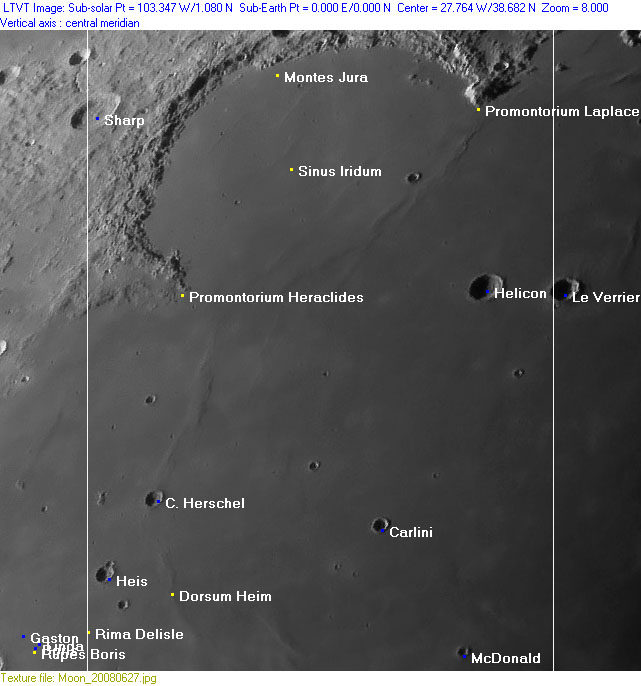Rükl 10
Contents
Rükl Zone 10 - SINUS IRIDUM
Neighboring maps on the Rükl Nearside Map:
| 10 |
||
Photographic Map
(This map is based on an Earth-based photograph that has been computer-corrected to zero libration. The vertical white lines indicate the left and right boundaries of the Rükl rectangle)
Background image source
Named Features
- Bianchini (Van Langren's Claramontii) (the southern part of this crater is noticeable at the upper margin of Chart 10, immediately north of Sinus Iridum and Montes Jura).
- Buzz Saw (the opposite of the Jewelled Handle effect at Sinus Iridum and Montes Jura), see: https://www.cloudynights.com/topic/551293-next-lunar-buzz-saw-early-monday-morning-sept-26/
- C. Herschel
- Carlini
- Cassini's Moon Maiden (see page Heraclides, Promontorium).
- Dorsum Bianchini G (an unofficial name from D.Caes for the wrinkle ridge eastward of Bianchini G on the floor of Sinus Iridum) (see also LPOD August 15, 2012).
- Dorsum Billet (an unofficial name from D.Caes for the wrinkle ridge eastward of Montes Jura, on the floor of Sinus Iridum) (this wrinkle ridge runs through an unnamed bowl-shaped crater which, according to D.Caes, should receive the official name Billet) (Félix Billet; the composer of "Billet's Rose" which shows the distribution of the first 19 high-order rainbows across the sky) (see also LPOD August 15, 2012).
- Dorsum Heim
- Dorsum Laplace A (an unofficial name from D.Caes for the pronounced wrinkle ridge immediately east of the bowl-shaped crater Laplace A at the eastern part of Sinus Iridum).
- East of Dorsum Heim north (a rather clumsy unofficial name from D.Caes for the thin wrinkle ridge east of the northern part of Dorsum Heim, north of Caroline Herschel).
- Heis
- Helicon (Riccioli's Helicon Cyzicenus, although Grimaldi's map (with Riccioli's nomenclature) only shows Helicon) (J.Hewelcke's Insula Erroris).
- Jewelled Handle (an unofficial name for a very well known clair-obscur phenomenon at the Montes Jura, always appearing during Waxing Gibbous Moon, when the sunrise terminator runs about "halfway" on the floor of Sinus Iridum, while the sun is already illuminating the arc of the mountains) (this phenomenon is observable through binoculars and small telescopes!) (additional note: the Jewelled Handle at Montes Jura was very well depicted in the first appearance of the Waxing Gibbous Moon in Stanley Kubrick's 2001: a Space Odyssey, when the globe shaped lunar lander Aries departed en-route to the moon, with professor Heywood Floyd in it) (great music of Strauss!). The opposite of the Jewelled Handle effect is known as the Buzz Saw.
- Lacus Laplace (an unofficial name from D.Caes for the "flat" region about halfway between Promontorium Laplace and Maupertuis).
- Laplace hillocks (an unofficial name from D.Caes for the cluster of hillocks west of Promontorium Laplace, on the northeastern part of Sinus Iridum's floor).
- Luna 17 (soft-landed on November 17, 1970, south of Promontorium Heraclides) (Luna 17 delivered mankind's first 8-wheeled unmanned rover on the moon; known as Lunokhod-1).
- Mare Imbrium (Van Langren's Mare Austriacum, J.Hewelcke's Mare Mediterraneum) (occupying the lower right section of Chart 10).
- McDonald (once called Porthouse by H.P.Wilkins).
- Montes Jura
- Promontorium Heraclides (Van Langren's Crugeri) (?) (and... Prom. S. Vincetti) (E.A.Whitaker seems to be uncertain about Crugeri).
- Promontorium Laplace (Van Langren's Prom. Clavii, J.Hewelcke's Prom. Apollinis (?) (E.A.Whitaker seems to be uncertain about that one).
- Rabakuw (this is a rather strange name from G.H.Lindop for Bianchini W at the southeastern part of Bianchini itself) (see also Additional Information below).
- Rima Delisle (called Rima Verdi on Lunar Topographic Orthophotomap 39-B2).
- Ring (a nickname from D.Caes for a curious ring shaped formation which could have been a normal bowl shaped crater, located at LAT 31.37 / LON -25.79, west of Carlini L).
- Sharp (Van Langren's Rechbergeri) (together with Sharp B this was J.Hewelcke's Mons Atlas Minor).
- Sinus Iridum (Bay of Rainbows, note: lots of small craterlets and wrinkle ridges in Sinus Iridum should get the names of scientists mentioned in Carl B. Boyer's book The Rainbow; From Myth to Mathematics) (Sinus Iridum was Van Langren's Sinus Geometricus, J.Hewelcke's Sinus Apollinis).
- Sinus Iridum highlands (a disallowed name from T.G.Elger for the mountainous region northwest of Sinus Iridum and Montes Jura).
- Tacquetti (Van Langren's disallowed name for Promontorium Laplace Alpha).
- Weka crater (a nickname from M.J.S.Collins for a curious formation west-southwest of Helicon, see LPOD Small Mystery).
Luna-17 with rover Lunokhod-1
(south of Promontorium Heraclides)
In addition to the above, although not yet indicated on the present maps, 12 closely-spaced small craters explored by the robotic rover Lunokhod-1 were given names by the IAU on June 14, 2012:
Lettered Crater Locations
(click on the thumbnails to display full-sized images; use browser BACK button to return - the dashed white lines are the midpoints of the Rükl zones)
Full zone with lettered craters:
Lettered craters by quadrants:
| North West |
North East |
| South West |
South East |
Additional Information
- Other online descriptions of features in this Rükl map section:
Geoffrey Hugh Lindop's possible revolution in lunar nomenclature
On page 47 of the january 1979 issue of Spaceflight (a well-known magazine for rocket and spaceship addicts) appeared a curious letter by a certain Geoffrey Hugh Lindop, who wanted to change the entire catalog of lunar nomenclature into some sort of lettered code system. In his letter, he included two examples of his system: RABAKUW (the IAU's Bianchini W) and RAFELON (the IAU's Plato F). After reading his letter about a dozen times, I still don't understand his method. G.H.Lindop's system could be a VERY interesting one (!), but he didn't give much explanation... (or rather: "a much too complicated" explanation). (the two examples were not enough to comprehend Lindop's way of thinking). - DannyCaes Jan 7, 2016





